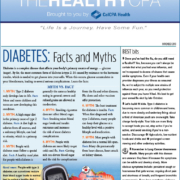Pre-Diabetes: Signs and Prevention
 What is pre-diabetes?
What is pre-diabetes?
Pre-diabetes means your blood sugar level is higher than normal, but not yet high enough to be classified as type 2 diabetes. However, without intervention, pre-diabetes can become type 2 diabetes in 10 years or less.
If you have pre-diabetes, the long-term damage of diabetes – especially to your heart and circulatory system — may already be starting.
Here’s the good news: Progression from pre-diabetes to type 2 diabetes isn’t inevitable.
With healthy lifestyle changes — such as eating healthy foods, including physical activity in your daily routine and maintaining a healthy weight — you may be able to bring your blood sugar level back to normal.
STEP ONE: Know the Risks
People who fit the following descriptions are more likely to develop diabetes:
- Overweight
- Exercise fewer than three times a week
- Have a brother, sister or parent with diabetes
- Gave birth to a baby who weighed more than nine pounds
- 45 years old or older
- African American, American Indian, Asian American, Hispanic American/Latino, Pacific Islander*
* People of certain racial and ethnic groups are more likely to develop type 2 diabetes than others.
Research shows that modest weight loss and regular physical activity can help prevent or delay type 2 diabetes by up to 58% in people with pre-diabetes.
STEP TWO: Find your healthy weight
If you’re overweight, you’re more likely to get pre-diabetes. By losing 5% to 7% of total body weight, you can lower your risk. A good diet can lower your weight and improve overall health.
STEP THREE: Choose the right foods
Eat More:
- Fruits and vegetables
- Legumes (beans, lentils, chickpeas, etc.)
- Whole grains
- Unsalted nuts
- Lean meats
Eat Less:
- Salty snacks
- “White” carbs (like white bread, pasta and rice)
- Sugary drinks
- Saturated fats and trans-fatty acids
STEP FOUR: Get Active
Even light exercise like walking or swimming can make a huge difference. Try and make regular activity part of your routine.
Remember, Small Changes Make A Big Difference!
Next time you order a sandwich, ask for it open face on whole grain bread, with extra veggies and hold the mayo. Find ways to walk more or incorporate light exercise into your daily routine. Be creative and find a support network that shares your goals. You can do it!
Sources:
National Institutes of Health: http://health.nih.gov/
National Institute of Diabetes and Digestive and Kidney Diseases: http://www.niddk.nih.gov/
National Center for Chronic Disease Prevention and Health Promotion: http://chronicdisease/index
World Health Organization: http://www.who.int/
Additional resources:
Centers for Disease Control and Prevention: http://www.cdc.gov/diabetes/prevention/prediabetes.htm
American Diabetes Association: www.diabetes.org
National Institute of Diabetes and Digestive and Kidney Diseases: www.niddk.nih.gov
U.S. National Library of Medicine and National Institutes of Health:
http://www.nlm.nih.gov/medlineplus/ency/article/001214.htm
Source: National Diabetes Education Program: http://www.ndep.nih.gov/diabetes/pubs/DPP_FactSheet.pdf
This information is intended for educational purposes only, and should not be interpreted as medical advice. Please consult your physician for advice about changes that may affect your health.


Leave a Reply
Want to join the discussion?Feel free to contribute!